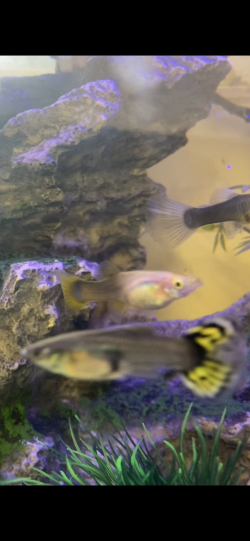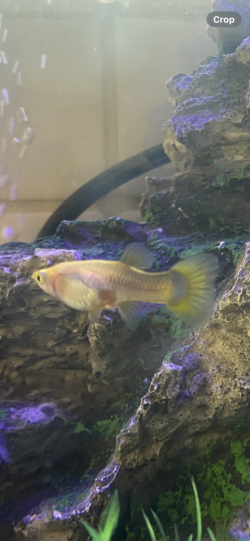Probably at least 2 weeks away, maybe 3 for the slimmer ones.
Female livebearers can carry up to 6 sperm packets (sometimes more) from breeding with males and they use 1 sperm packet to fertilise each batch of eggs. The gestation period (from the time she fertilises the eggs to when she gives birth to free swimming babies) is about 1 month. After which she will fertilise another batch of eggs using another sperm packet. This allows female livebearers to produce young about once a month for up to 6 months without any males being present.
It is preferable not to move pregnant fish because you can stress them and even damage the unborn fry. If you have to move pregnant females, carefully catch them in a net and then use a plastic container to scoop the female and net up in some tank water. Move her (in the net in the bucket of water) to a new tank and then carefully pour her into the new tank.
If you move the female to a smaller aquarium that would stress her.
If you use completely new water in the new tank it would stress her. If you set up a new tank for her you should fill the new tank with water from her current tank, so the water is exactly the same.
If the new tank does not have any plants in it will stress her. Put some plants in with her. Water Sprite (Ceratopteris thalictroides/ cornuta) is the best plant for livebearers. It normally grows on the surface but can also be grown in the substrate where it grows into a lovely light green shrub.
If you don't have any live plants then add a heap of artificial plants to provide her with shelter when she goes into labour, and to give the fry somewhere to hide when they are born.
Make sure the new tank has an established filter in it so the water stays clean.
Do not put the female into a tank with males until at least 1 week after she has given birth otherwise the male/s will stress her out.
Try not to move the female for at least 1 week after she has given birth so she can heal up. If you have to move the female after she has given birth, use the method above for moving pregnant females.
Most female guppies do not eat their young if the female is well fed and there are plants in the tank, but will eat them when they are confined to a small breeding trap.





